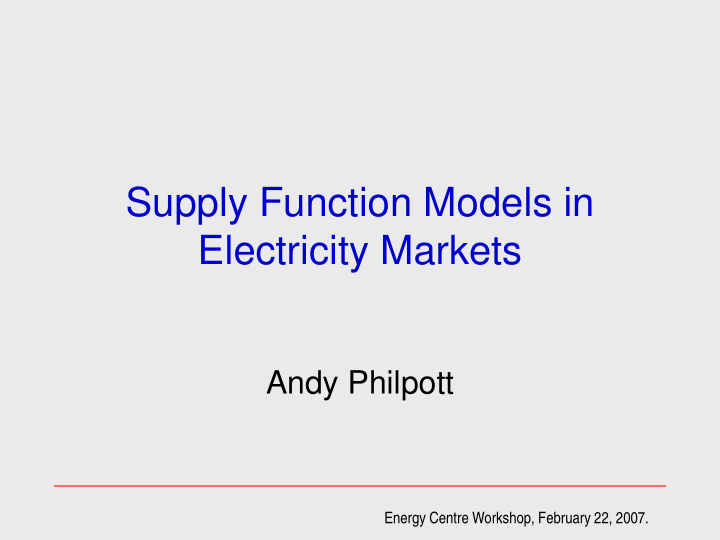



Supply Function Models in Electricity Markets Andy Philpott Energy Centre Workshop, February 22, 2007.
Motivation • Many pool markets use supply-function offers… • …but most models are Cournot… • …even though with uncertainty in demand the SF model gives more realism. • Why? SFE models [Wilson (1979), K&M(1989)] are difficult to work with. • Market distribution function is a powerful tool to work with supply functions. • Aim to illustrate this by some examples. Energy Centre Workshop, February 22, 2007.
Residual demand curve S(p) = supply curve from other generators p D(p) = demand function RDC = D(p) – S(p) R(q,p) = qp – C(q) Optimal dispatch point to maximize profit q Energy Centre Workshop, February 22, 2007.
A distribution of residual demand curves p RDC shifted by random demand shock d Optimal dispatch point to maximize profit q Energy Centre Workshop, February 22, 2007.
One supply curve optimizes for all demand realizations p q Energy Centre Workshop, February 22, 2007.
This doesn’t always work p q Energy Centre Workshop, February 22, 2007.
Suppose • these functions are log concave (e.g. q n ) • generator cost function is convex p Then a monotonic optimal supply curve exists q Energy Centre Workshop, February 22, 2007.
The monotonicity theorem [Anderson and Philpott, 2002] Energy Centre Workshop, February 22, 2007.
The market distribution function [Anderson and Philpott, 2002] Energy Centre Workshop, February 22, 2007.
Application: offer curve optimization • BOOMER (Pritchard) • Single period simulation/optimization model • Model (uncertain) generator stacks of competitors by sampling from probability distributions • Solve pricing-dispatch problem for every sample • Construct optimal stack for particular objective in mind • Objective can include contracts, FTRs, retail load Energy Centre Workshop, February 22, 2007.
Contracts A contract for differences (or hedge contract) for a quantity Q at a strike price f is an agreement for one party (the contract writer) to pay the other (the contract holder) the amount Q(f-p) where p is the spot price. Having written a contract for Q , the generator seeks to maximize R(q,p) = qp - C(q) + Q(f-p) Energy Centre Workshop, February 22, 2007.
Example market distribution function Energy Centre Workshop, February 22, 2007.
Generator’s objective function Owner of Huntly might have wanted to maximize Gross revenue at HLY + TKU + RPO –$35/MWh fuel cost at HLY –cost of purchases to cover retail base of • 25% at MDN/HND/OTA/WKM • 10% at ISL/HWB accounting for hedge contracts at $50/MWh of • 250MW at OTA • 150MW at HAY • 50 MW at HWB (Numbers are illustrative only!) Energy Centre Workshop, February 22, 2007.
Energy Centre Workshop, February 22, 2007.
Energy Centre Workshop, February 22, 2007.
Behaviour of optimal supply curves Energy Centre Workshop, February 22, 2007.
Application: the value of vertical integration S(p)=p Other (competitive) generators d OTA q(p) ? (Mercury) (MRP) d Other retail Energy Centre Workshop, February 22, 2007.
Optimal offer of gentailer Energy Centre Workshop, February 22, 2007.
Optimal offer with vertical integration Energy Centre Workshop, February 22, 2007.
Compare a contract Q at price π Energy Centre Workshop, February 22, 2007.
Optimal offer with contract Energy Centre Workshop, February 22, 2007.
The best payoff obtainable by contracting Energy Centre Workshop, February 22, 2007.
Compare payoffs The joint payoff when vertically integrated is The joint payoff when contracted optimally is The difference in expectation is Energy Centre Workshop, February 22, 2007.
Symmetric supply function equilibria Energy Centre Workshop, February 22, 2007.
Symmetric SFE when holding contracts [Anderson and Xu 2001] Energy Centre Workshop, February 22, 2007.
Symmetric Cournot equilibrium with contracts Assume constant marginal cost c and a linear inverse demand curve P ( x ) = A - Bx Nash equilibrium offer for each agent is A+BQ q = 3B+c Energy Centre Workshop, February 22, 2007.
Symmetric SFE (A=4, B=1, c=1, Q=2) 4 3 p 2 1 0 1 2 3 4 q Energy Centre Workshop, February 22, 2007.
SFE with transmission losses [P & Jofre (2006)] Energy Centre Workshop, February 22, 2007.
Strong and weak SFE Energy Centre Workshop, February 22, 2007.
Existence of weak SFE Energy Centre Workshop, February 22, 2007.
Example of strong SFE in network Generation cost = 0.5q 2 S 1 (p) S 2 (p) 1 2 y + 0.2y 2 y y – 0.2y 2 d-p d-p Energy Centre Workshop, February 22, 2007.
0.7 S(p) 0.6 S(p)=( √3 -1)p 0.5 0.4 0.3 0.2 0.1 p 0 0 0.1 0.2 0.3 0.4 0.5 0.6 0.7 0.8 0.9 Energy Centre Workshop, February 22, 2007.
Pay-as-bid auction models [Anderson & P (2007)] Energy Centre Workshop, February 22, 2007.
Behaviour of optimal curves Energy Centre Workshop, February 22, 2007.
Symmetric pay-as-bid SFE Energy Centre Workshop, February 22, 2007.
Comparison PABA and uniform 1000 Price 800 Uniform price PABA bid 600 PABA average price 400 200 Demand 0 0 2000 4000 6000 8000 10000 Source: Holmberg (2006) Energy Centre Workshop, February 22, 2007.
Example: uniform demand shock q+p=1 Z>0 Optimal offer (c=0) Z<0 Energy Centre Workshop, February 22, 2007.
Mixed-strategy SFE Energy Centre Workshop, February 22, 2007.
Mixed-strategy SFE Energy Centre Workshop, February 22, 2007.
Conclusions • Supply function models are appropriate in presence of uncertainty (e.g. demand) • Give qualitatively different answers to Cournot models. • Analytical difficulties can be attacked using market distribution functions. • Difficulties remain in general settings (but these are not just SFE problems) Energy Centre Workshop, February 22, 2007.
Recommend
More recommend